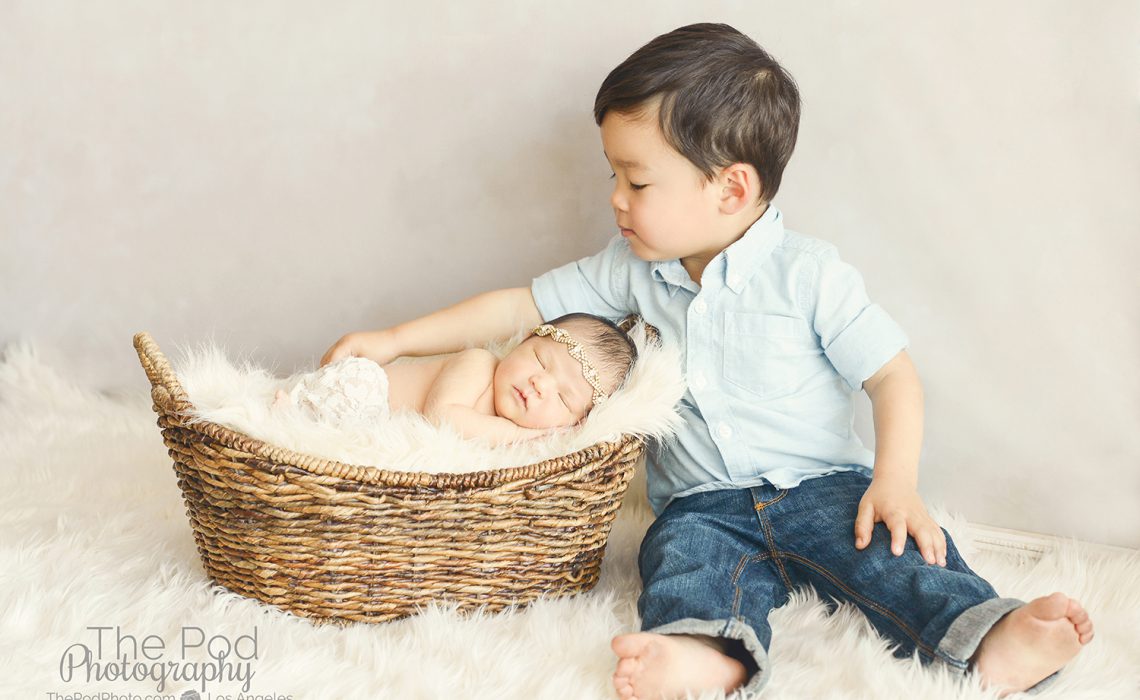
This oh-so-cute family came to our Santa Monica portrait studio for their daughter’s newborn pictures, and of course big brother was along for the show!
Sibling photos are incredibly difficult to capture when the older sibling is younger than about 3 – and so we had to pull out all the stops to get the family and sibling portraits this mama wanted. If you think about it, toddler age kids are just discovering the world and just starting to understand language, asserting their independence and figuring out their roll in their family unit. Two year olds are difficult enough for us to photograph at our studio when we are just on-on-one with them, but when you add the dynamic of their new baby sister who is now stealing the show, well – let’s just say we’ve seen it all! From outright fear of the new baby, to ignoring them completely and then even the occasional pinch when the baby cries – even the best behaved sweet child can act out the first few months during the adjustment to his new baby sibling. This particular little boy did none of those things – except of course the typical constant businesses of being a toddler and always wanting to be on the MOVE – but it still took our entire team to be able to capture him perfectly in photos.
When shooting family pictures, we at our Santa Monica professional photography studio, always shoot in teams of 2-3 people with an occasional 4th team member called in when it gets really tough. There’s always the photographer, then one person making the kids smile, and then third person is the “baby wrangler.” That person’s job is to pick up the child every time they run away from their photo spot and put them right back. With a toddler, that can be as many as 1-3 times per minute because they have such short attention spans and are always being called by something interesting they see at our studio. When we have two runner kids – well that’s when our designer stops what she’s doing and comes in to lend a hand.
The thing is – kids will be kids. We never get upset with a toddler who has his mind set up that all he wants to do is run from us, or the shy little boy who we need to speak really quietly to and coax his face from mom’s side – because that is the beauty of all children: they are all unique, yet at the same time all going through the same developmental stage at the same age. We usually know what to expect with children of each age – but it’s the ones who surprise us that make our jobs really fun!!
We’d love to get to know your family and capture beautiful images that tell your family’s story! Take a look at our website and give us a call at 310-391-4500!
Here are some great adjustment tips and what to expect for those with a two year old from Parenting.com:
How is my child likely to react to a new baby in the house?
Even if he was excited about having a new sibling before the birth, your toddler may change his mind once the baby comes home. How your child behaves will depend partially on his temperament. Children who are more flexible and self-contained may adjust more easily. Those who are highly sensitive, need more time with transitions, and like routines may take longer to adjust.
Your firstborn may react to the addition of a new family member by testing you or regressing (sitting in the baby’s seat, wanting a diaper, or asking to drink from a bottle). He’s likely to want your attention most when you’re nursing or changing a diaper.
He may even try to express his feelings by yanking the baby’s arm or snatching her toys. You can respond by saying something like, “I want you to be gentle with the baby. It can hurt her to pull on her arm. If you need to pull on something, you can pull your wagon.” Show your toddler how to touch his sister gently. (See our piece on aggression in 2-year-olds for more tips on dealing with this behavior.)
Most likely your child will also be eager to show his new sibling affection and connect with her. Read on for tips on how to help your toddler accept and even enjoy the new baby in your lives.
What can I do to help my child accept a new sibling?
Give him special jobs. Let your firstborn help out — he may surprise you with how much he can do. When you bathe the baby, he can help soap her legs. He will probably be happy to fetch diapers or a new set of clothes. When the baby cries, ask him to gently pat her back or talk softly to her. If he wants to hold his new sibling, set him up next to you and share the baby across your laps. Or have him sit in a chair with pillows on either side of him, then prop the baby in his lap. Stay nearby and be alert. He may be done after a few seconds and try to dump her off his lap. (He isn’t trying to hurt her. He may just think of her as a toy.)
Ask his advice. Ask your toddler: “Do you think the baby would like to wear the blue shirt or the yellow shirt?” or “Do you want to help me tell a story?” Toddlers often have a natural flair for entertainment — singing, dancing, or just making faces — and a baby is an appreciative audience. Not only will your child enjoy the attention, he’s likely to take pride in bringing a smile to his sibling’s face.
Watch the baby together. Invite your child to observe the baby with you. Hold him close and ask him to describe what he sees. “Look at her hands. They’re so little. Can you see her kicking her feet? Can you kick your feet like that?”
Read stories about his new role. Reading stories about babies or about new siblings can help your toddler adjust to his new situation. Stories that show children enjoying and taking pride in their little sibs present positive role models for your child. Joanna Cole’s gender-specific I’m a Big Sister and I’m a Big Brother are good places to start.
Let him tell the story. Make a simple picture book of your family. Ask your toddler what pictures he would like to have in the book or include some of your favorites together. Once the pictures are in the book, you can ask him what words he’d like on each page or add a simple text yourself.
Acknowledge his feelings. It’s normal for your toddler to feel a range of feelings about this new change in his family. After all, he suddenly has to share you with someone who requires an extraordinary amount of your time and attention. Rather than scolding him, acknowledge his feelings: “It seems like you’re feeling sad right now. Do you want a hug or a story?” Or “It’s hard when you want me to do something and I need to help the baby.” He may just need to know you understand his feelings and that you can take a minute to listen to and hold him.
Spend a little time alone with him. Spend some time each day with just your toddler, even if it’s only a few minutes of drawing or building with blocks. This time makes him feel special and reminds him that you’re his mommy as well as the baby’s.
Let him do his own thing. If your toddler doesn’t want to be involved with the new baby, don’t push it. A lot of kids cope with the change by “ignoring” their tiny siblings — at least for a while. So you don’t need to expect him to play a greater role than he wants to. He’ll come around in time.
Check out our collection of Parents’ Voices to see how other parents helped their older children adjust to a new baby in the family. See our piece on solving sibling rivalry for more tips on helping your children bond.
NOTE: This piece was reviewed by Janis Keyser, parenting educator, co-author of Becoming the Parent You Want to Be, and a member of theBabyCenter Medical Advisory Board.

















